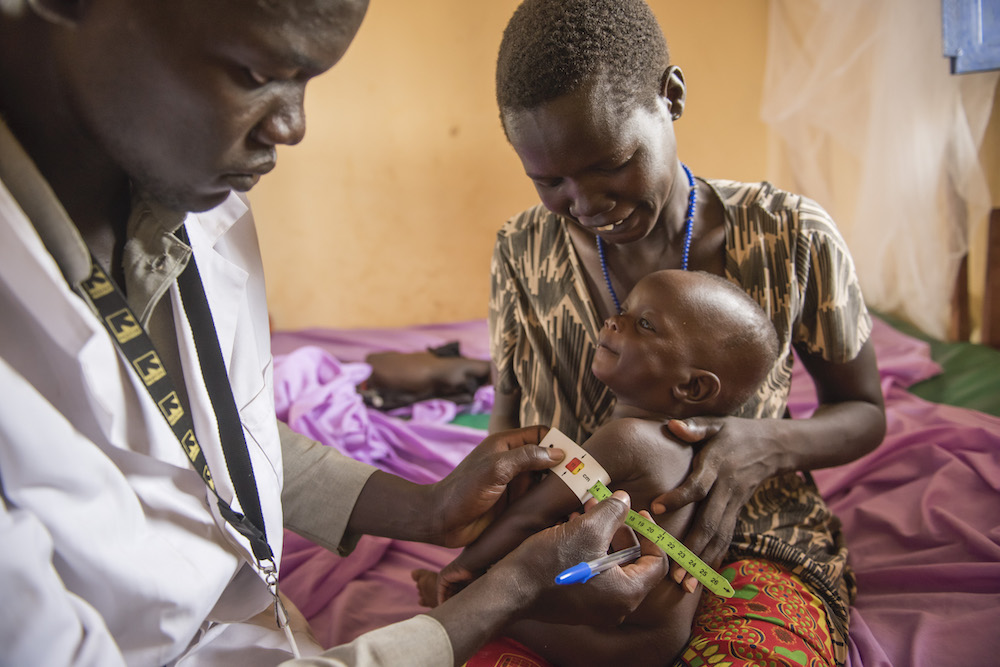
Transforming Treatment for Acute Malnutrition
Transforming the way acute malnutrition is treated to save lives and cost
IRC is proposing a suite of five approaches to simplify treatment for acute malnutrition and to make it more accessible. Alongside an ambitious advocacy campaign, they have the potential to transform the way children with acute malnutrition are treated.
Acute malnutrition is a continuum condition meaning a child’s condition improves or deteriorates continuously along a single spectrum. Today, children suffering from acute malnutrition are divided into two different categories based on the severity of their illness: severe acute malnutrition (SAM) and moderate acute malnutrition (MAM). This impacts what kind of treatment they access, where treatment is available to them, and far too often, whether they can access treatment at all.
Treatment for SAM and MAM is rarely available at the same place and time and in many locations, treatment for MAM is not available at all, meaning children must wait until their health deteriorates before accessing the care that they need. Worse still, the treatment for both conditions is currently available only in formal health facilities putting the burden on families to traverse long, often dangerous distances, to reach the life-saving care their children desperately need.
This system is inefficient and makes it difficult for children to access the care they need. In fact, less than 20% of acutely malnourished children receive the treatment they need to fully recover.
The five interventions
- Combined, simplified treatment of SAM and MAM: Under a combined approach**,** children with SAM and MAM are treated together in the same physical location, using a tailored dose of one product. This is simpler for health providers to implement and relies on fewer treatment products to deliver the same health gains.
- Delivering Care Through Community Health Workers (CHWs): TheIRC has piloted and tested the feasibility of delivering treatment through community health workers, which enables families to access care directly in the communities they live from providers they know. The IRC designed and developed simplified tools to support even low-literate CHWs to accurately diagnose and treat acute malnutrition.
- Parents Monitoring and Diagnosing Malnutrition at Home: Several clinical trials and operational studies have shown caretakers can be trained to accurately diagnose malnutrition in their own children. Empowering caretakers to manage the screening process allows children to be identified and referred to care more quickly.
- Locally-sourced and Produced Ready-to-use Foods: Ready-to-use food (RUF) makes it possible for children to be treated in their own homes. These products are typically produced in/shipped from Europe and the United States. Locally-sourced and produced RUF would allow more children to be treated for less cost.
- Integrating Treatment and Prevention: The IRC is testing a series of strategies to prevent malnutrition in vulnerable communities. The next step is integration – linking families of malnourished children with resources to prevent malnutrition from reoccurring.
Where we are now
The IRC is generating evidence around these innovative approaches. Our research and pilot studies already suggest that these approaches are feasible and can have a transformative impact on the lives of children around the world.
The IRC is also leading and ambitious advocacy campaign to ensure these approaches will be endorsed, adopted into policies and guidelines, and adequately financed. This requires elevating acute malnutrition as a priority for global donors, targeting stakeholders from peer organizations, and working directly with the U.N. to build the consensus and political will needed to see these approaches put into action.
Project Timeline
We have now treated over 100,000 children with the simplified protocol across multiple countries, building a strong evidence base on effectiveness and cost-effectiveness of simplified approaches in many contexts.
We will be combining our database - which has detailed, patient-level data, with those from our partner organizations, Action Against Hunger and Save the Children, this year. By combining data, we’ll be able to conduct rapid analyses on the simplified protocol to answer new research questions and support policymakers.
Published an effectiveness study from our operational research Mali in Nutrients, a peer-reviewed journal
This study reviewed results from over 27,000 patients treated with the simplified protocol since 2018. The results were very strong. We demonstrated that the simplified protocol is highly effective – patients had an overall recovery rate of 92%, a mean length of stay (the amount of time in treatment) of 40 days, and a mean RUTF consumption of 62 sachets. We also demonstrated that Community Health Worker (CHW) delivery of treatment is just as effective as care in a health facility, and makes treatment more accessible – CHWs recovered patients at a 94% rate.
Resource